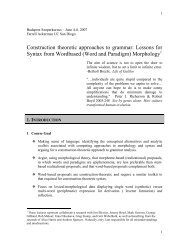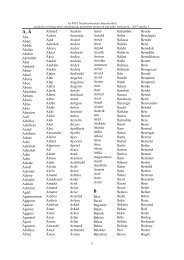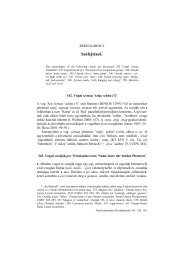Nyelvtudományi közlemények 91. kötet (1990)
Nyelvtudományi közlemények 91. kötet (1990)
Nyelvtudományi közlemények 91. kötet (1990)
Sie wollen auch ein ePaper? Erhöhen Sie die Reichweite Ihrer Titel.
YUMPU macht aus Druck-PDFs automatisch weboptimierte ePaper, die Google liebt.
Once again on Language and Music<br />
(A semiotic approach)<br />
In order to be able to raise the question of the relation between music<br />
and language at ail, one has first to find a basis of comparison. Such a basis<br />
can be material, genetic, functional, etc. (cf. Harweg 1968). The présent<br />
paper is putting forward afunctional-semiotic basis of comparison and starts<br />
out from the opinion that "music is language, i.e. one of those Systems of<br />
communication whereby human beings can exchange meanings and values"<br />
(Ruwet 1972. 26). As a starting point, then, we hâve to admit that music,<br />
just like language, is a code with a specific Organization, which reflects the<br />
reality outside it in a specific way. In the past décades this récognition has<br />
proved fruitful in the phonological and syntactic approaches to the relation<br />
between language and music (see e.g. Jakobson 1932, Ruwet 1972), and<br />
later also in the development of a semantically oriented musicology. (This<br />
latter development lias been associated especially with the names of Asafyev<br />
in the Soviet Union, Zieh, Sychra, Jiránek and others in Czechoslovakia,<br />
cf. Doubraová 1981).<br />
Music expresses the inner world of man, i.e. primarily his feelings, émotions<br />
and the ideas dissolved in thèse. This statement is by no means new:<br />
it can be found in the ethos-theory of the Ancient Greeks, as well as in<br />
the philosophical and aesthetic literature of the 18th and 19th centuries (in<br />
Rousseau, James Harris, Twinning, Kant, Hegel, etc.; cf. the relevant places<br />
in Pfrogner 1954 Zoltai 1969). It is not a new idea either that music conjures<br />
up the inner life of man by imitating it as such, rather than by representing<br />
the external world: music is the mimesis of inner life (Lukács 1963. 346).<br />
The most important feature of this mimesis is what Lukács calls indeterminate<br />
objectivity. Needless to say, this notion also has its antécédents. For<br />
instance, when comparing music and the visual arts, Kant remarks that the<br />
path of music leads from sensations to indeterminate ideas ("von Empfindungen<br />
zu unbestimmten Ideen"), whereas the path of the visual arts leads<br />
Nyelvtudományi Közlemények <strong>91.</strong> <strong>1990</strong>.


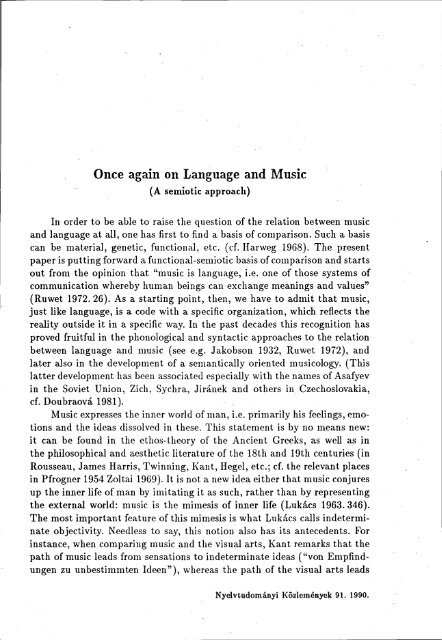

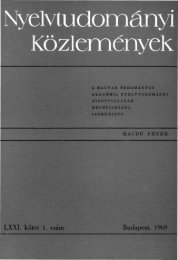

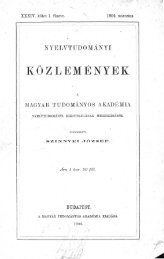
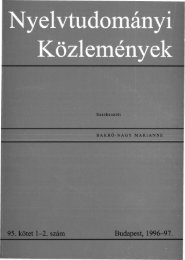
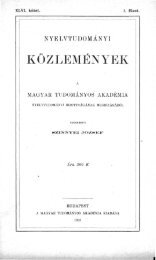
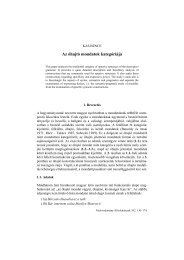
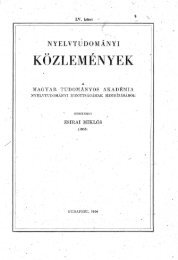
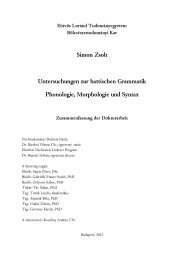
![Gósy Mária: A [p, t, k] mássalhangzók zöngekezdési ideje Bevezetés ...](https://img.yumpu.com/15682849/1/190x245/gosy-maria-a-p-t-k-massalhangzok-zongekezdesi-ideje-bevezetes-.jpg?quality=85)

